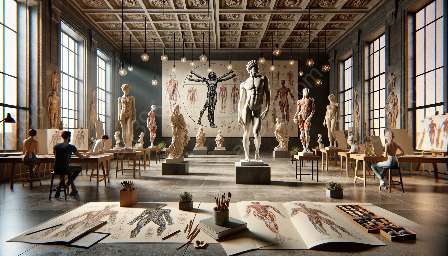Figure drawing is a fundamental aspect of visual storytelling and narrative expression. It serves as the basis for creating compelling characters and conveying emotions, actions, and environments. This guide explores the intersection of figure drawing, storytelling, and artistic anatomy, providing valuable insights for artists seeking to enhance their skills in visual storytelling.
Understanding the Importance of Figure Drawing in Storytelling
Figure drawing plays a crucial role in storytelling by enabling artists to depict the human form in various poses and situations. Through figure drawing, artists can bring characters to life, evoke emotions, and establish visual narratives that resonate with audiences. Whether it's illustrating a climactic battle scene, capturing the grace of a dancer, or portraying the subtle nuances of facial expressions, figure drawing serves as the visual foundation for conveying storytelling elements.
Exploring Figure Drawing Techniques
Mastering figure drawing requires a combination of observational skills, anatomical knowledge, and technical proficiency. Artists need to understand the dynamics of human movement, proportions, and gestures to effectively communicate narrative expression through their artwork. This section delves into various figure drawing techniques, such as gesture drawing, quick sketching, and long pose studies, providing practical tips and exercises to hone artists' figure drawing abilities.
Gesture Drawing
Gesture drawing is a dynamic approach to capturing the essence of a pose or action in a quick and fluid manner. It focuses on conveying the energy, rhythm, and flow of the human figure, allowing artists to distill the essential gestures and movements that communicate the narrative intent. Through gestural mark-making and rapid sketches, artists can infuse their drawings with vitality and spontaneity, essential for evoking emotion and narrative impact.
Anatomical Understanding and Artistic Anatomy
Artistic anatomy forms the foundation for realistic figure drawing, providing artists with an in-depth understanding of the human body's structure, muscles, and skeletal framework. By delving into artistic anatomy, artists can create more convincing and engaging characters, accurately capturing the complexities of human form and movement. This section delves into the principles of artistic anatomy, offering insights into skeletal and muscular landmarks, body proportions, and the interplay of form and function.
Integrating Figure Drawing with Narrative Expression
Effective storytelling through figure drawing involves more than just technical proficiency. It requires artists to infuse their drawings with narrative intention, emotional resonance, and visual storytelling techniques. From character design to scene composition, artists need to consider how their figure drawings contribute to the overall narrative and engage viewers on an emotional and intellectual level. This section delves into the fusion of figure drawing and narrative expression, exploring how artists can imbue their artwork with compelling storytelling elements, character development, and environmental context.
Applying Figure Drawing in Visual Narrative
Figure drawing finds its ultimate purpose in contributing to visual narratives, whether in illustration, comics, animation, or concept art. Artists seeking to pursue careers in these fields need to understand how figure drawing intertwines with narrative storytelling across various mediums. This section provides insights into the practical application of figure drawing in visual narratives, offering guidance on creating sequential art, dynamic character poses, and evocative storytelling compositions.
Cultivating Your Figure Drawing Skills for Narrative Mastery
To harness the full potential of figure drawing for storytelling and narrative expression, artists must dedicate themselves to continuous improvement and exploration. This section presents a holistic approach to cultivating figure drawing skills, encompassing ongoing practice, anatomical studies, and creative experimentation. By nurturing their figure drawing abilities and integrating narrative expression, artists can elevate their storytelling prowess and captivate audiences through their visual narratives.

